Six-year-old Michael Mosier was diagnosed with a tumor in his brain stem on September 4, 2014 -- just one week after his birthday and his first day of kindergarten.
For the sports-loving Maryland preschooler, the journey that followed has been unimaginably difficult. But throughout his seven months of chemotherapy, radiation and major body changes, he has proven to be a real hero. Now, Michael is raising money for cancer research so that other kids don't have to experience what he's gone through.
In May, Michael and his family will participate in the Race for Hope in Washington, D.C. -- a 5K charity run/walk dedicated to raising funds for brain tumor research.
"We decided to register a team for the race this year," said Michael's mother, Jenny, "both to have a way to show Michael how much everyone supports him, and to do something proactive to contribute towards finding a cure."
As of April 14, Team Big Hero Michael -- named after one of Michael's new favorite Disney movies, "Big Hero 6" -- has raised more than $60,000 and counting.
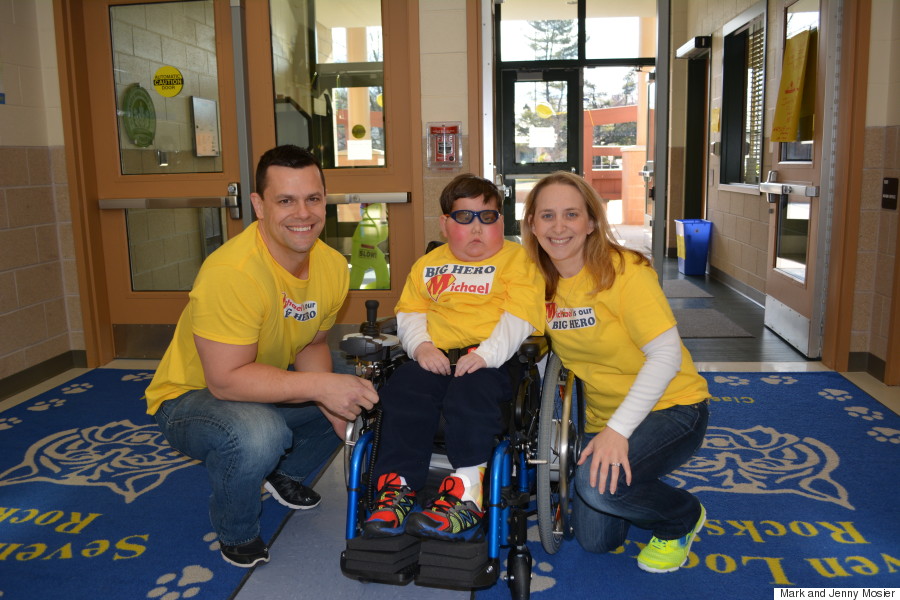
Michael with his parents, Mark and Jenny, in March 2015.
The generous donations from friends, family and even online strangers have meant the world to the Mosiers, who have had a roller coaster of a year. A March 3 Facebook post from Michael's parents tells the story, from Michael's diagnosis through his ongoing treatment. During Labor Day weekend last year, Michael's right eye stopped moving and blinking normally, and he began seeing double. A few days later, an MRI scan showed that Michael had diffuse intrinsic pontine glioma (DIPG), a type of brain tumor with which hundreds of children are diagnosed each year.
Jenny Mosier told The Huffington Post that Michael's diagnosis marked the darkest day of her life.
"To learn your child has cancer is a nightmare," she said. "To learn your child has cancer in his brain is particularly horrifying. Then, to learn that the specific type of brain tumor your child has is inoperable and without any effective treatment options... well, it inflicts a despair that words simply cannot capture."
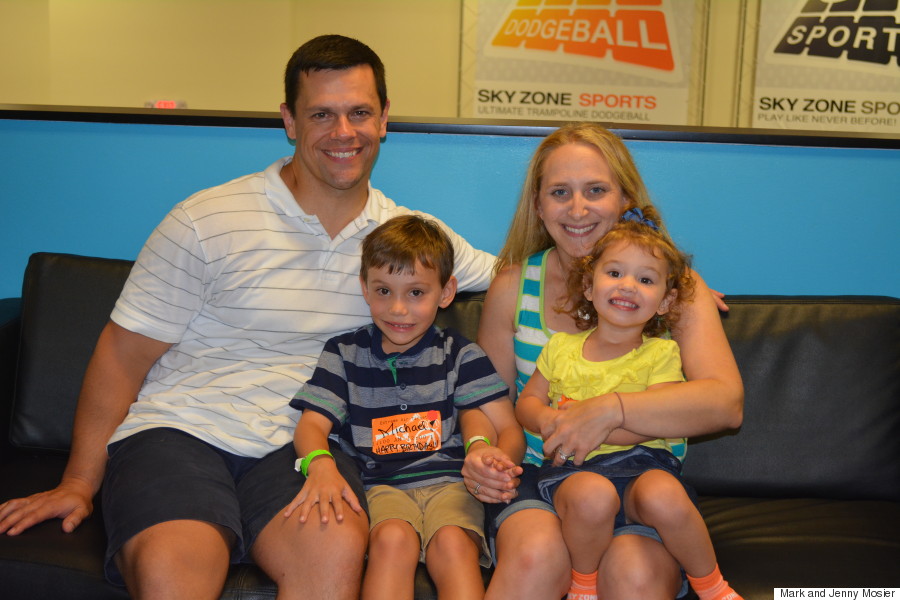
Michael with his parents and his sister, Lila, at his sixth birthday party in August 2014.
The Mosiers had never heard of DIPG before Michael's diagnosis, but now they're working to raise awareness about the inoperable disease, which commonly affects kids between the ages of 5 and 10. The symptoms of DIPG include double vision, loss of balance, limb weakness, difficulty walking, speech issues and problems chewing and swallowing.
"DIPG is so devastating because due to its location in the brain stem -- the central control system for our motor functioning -- it is extremely difficult to target without harming critical brain structures," said Jenny. She added that the aggressive nature of the disease and the lack of effective treatment options mean the prognosis is very bleak.
Recently, DIPG has made headlines due to Lauren Hill, a college basketball player from Indiana who raised more than $1 million for cancer research following her diagnosis. Hill passed away earlier this month at age 19, after a year and a half of battling the disease.
"DIPG is one of the few cancers in which the prognosis for a patient today is no better than the prognosis 30 years ago," said Michael's father, Mark, a partner at a Washington law firm. "Yet there are reasons to be optimistic that more effective treatments can be developed in the near future. We need to ensure that the doctors and researchers have the resources they need to develop these new treatments."
After receiving his diagnosis, Michael underwent 30 radiation treatments in October and November. He also received an experimental chemotherapy drug meant to enhance the radiation's effects. The radiation required Michael to lie under a large machine on his back, with his face in a mask that was fastened to the table.
"Typically, young kids must be sedated for their radiation treatments because you have to stay perfectly still," the Mosiers explained in their Facebook post. But Michael "battled through his terrible nausea" for each of his treatments so that the technicians wouldn't have to sedate him.
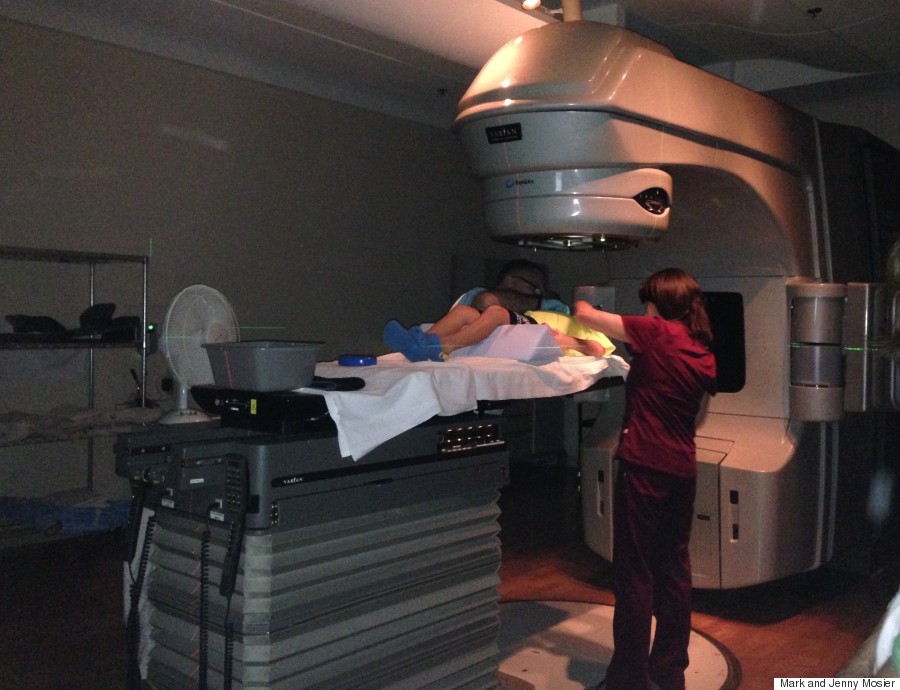

Michael preparing for radiation treatment at the National Institutes of Health in Washington, D.C.
Despite painful symptoms, invasive treatments, frequent trips to the hospital and near-daily doctor appointments, Michael has demonstrated unbelievable courage and strength and never complains, Mark told HuffPost. But the 6-year-old did not improve over the course of his radiation treatments, and his symptoms worsened, leading to severe vision loss and increased difficulty speaking, as well as the loss of motor functions like the ability to walk and the use of his left (and dominant) hand. On top of these DIPG symptoms, Michael has also grappled with some difficult side effects to his medications, including weight gain, nausea and fatigue.
Still, Michael tries to go to school whenever he can, and he works diligently with a teacher at home. It's all part of his seemingly indefatigable character. When he was hospitalized in February after aspirating fluid into his lungs, Michael fought through it until he regained his strength. "After the fact, his doctors told us that with his condition, they rarely see a child power through and come back from that type of acute incident," said Jenny.

Michael ready to leave the hospital in his "Star Wars" pajamas.
"Michael is a fighter. Pure and simple," his mother continued. "And he is a hero, because in the face of obstacles most of us could not bear, he not only keeps going -- he soars above all of our expectations. We could not be more proud of him every single day."
Over the past month, Michael has taken his battle to new heights with his Race for Hope fundraising. As the Mosiers gathered donations, a family friend suggested a fun way for the 6-year-old to get actively involved: a 50 states project. Seeking donations from people in all 50 states, Michael kept track of the family's progress by coloring in a map of the U.S. The Mosiers thought they would need at least a week to reach all 50 states, but Michael met his goal within 36 hours of the first Facebook callout.
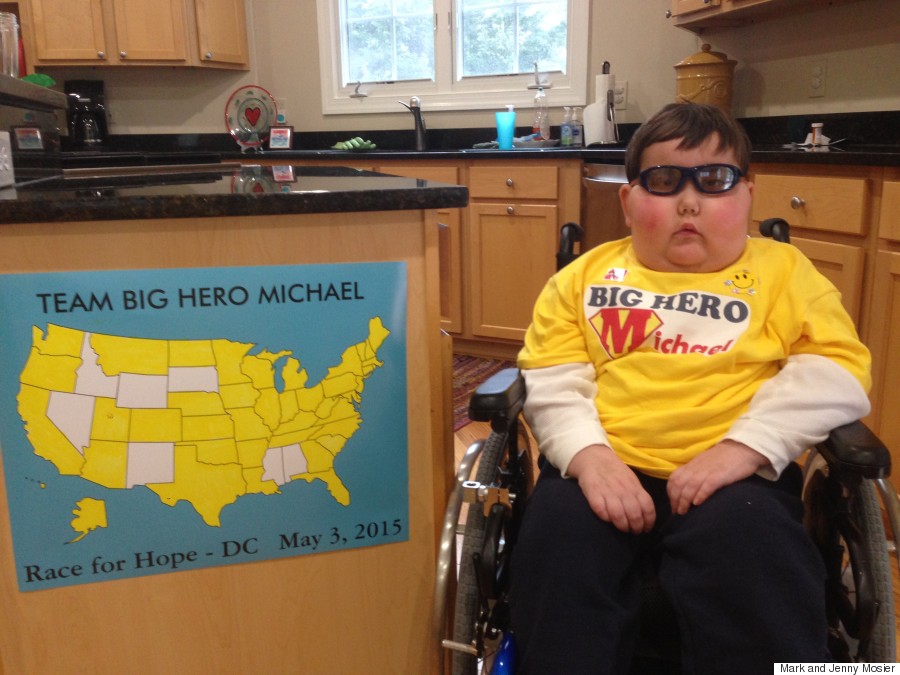

Michael's 50 states project.
After succeeding with his national project, Michael went global, seeking donations from people all over the world. So far, he's reached more than 30 countries, from Finland to Bulgaria to Kuwait to Nicaragua. This goal-oriented activity is perfect for Michael because he loves creating checklists, Jenny said. Every morning, he and his dad make a to-do list of everything he wants to accomplish, from playing with Legos to going to school or drinking a milkshake.
"He will not go to sleep unless the list is completed," Jenny wrote on Michael's Facebook page. "I love that list and every minute we get to spend checking off the items with Michael each day."
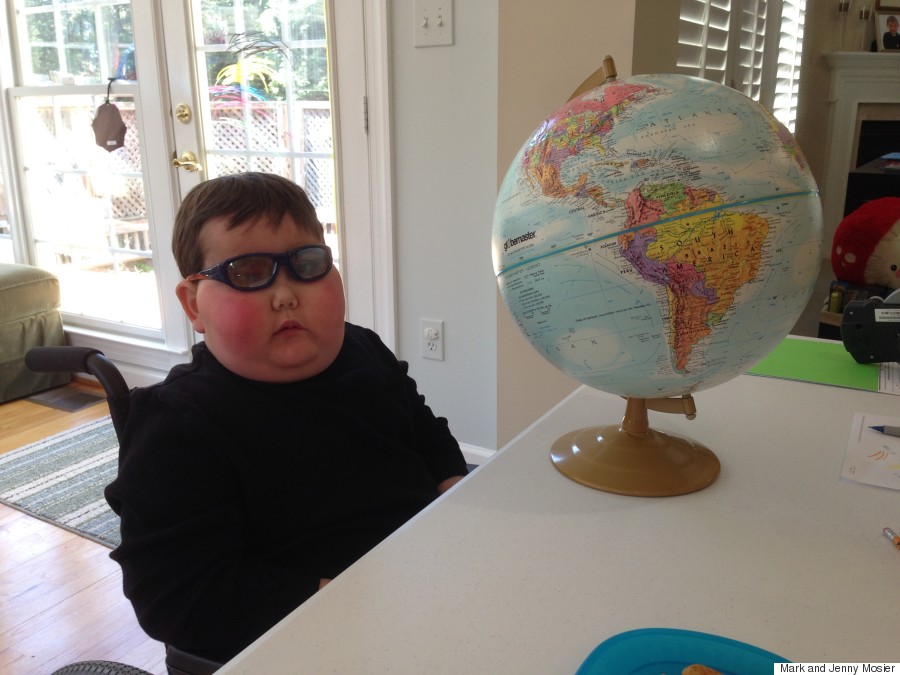
Michael starting his global project.
Michael is now receiving five days of chemotherapy every four weeks, his parents said, and his tumor has been stable for a few months. He completed his fourth round of chemo in March. The Mosiers and Michael's doctors monitor all changes in his symptoms, as well as the results of his regular MRI scans.
Jenny said she wants to remind parents to "enjoy every precious moment" with their children.
"The truth is that I often complained about how hard it is to be a parent," she said. "I do not back away from that sentiment -- I still think it is hard -- but I wish that in some of the moments when I was feeling overwhelmed or frustrated, I had the perspective to know that I was the luckiest person on the planet to have those kids driving me crazy."
"I would truly give anything to be chasing Michael somewhere because he wanted to run off and explore, or listening to him beg for just five more minutes at the playground, or mustering the energy for a nighttime baseball or soccer game in our basement after a long day," she added.

Michael and Lila at the hospital.
The Mosiers hope that people who learn about Michael's story will do something to direct more attention and resources toward finding new treatments and even a cure for DIPG. "One thing that has really struck me since entering the world of childhood cancer is that it seems that those advocating for the necessary resources, legislative and regulatory changes, and increased focus on finding better treatments and a cure for childhood cancer are the families that have suffered through these unbelievably challenging experiences," Jenny told HuffPost in an email.
"To watch families who have had to endure the immense pain of losing a child then shoulder the burden of trying to save other children and families from going through the same nightmare has really impacted me," she continued. "The minute this touches you or someone you care about, you think that EVERYONE in our society should be demanding whatever resources are necessary to make progress so our children do not have to suffer this way."
To help the Mosiers work toward progress, you can donate to their Race for Hope team and follow their story on the Facebook page My Hero Michael Mosier.
 Like Us On Facebook |
Like Us On Facebook |
 Follow Us On Twitter |
Follow Us On Twitter |
![]() Contact HuffPost Parents
Contact HuffPost Parents